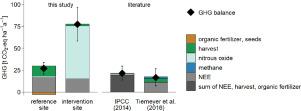Agricultural and Forest Meteorology ( IF 5.6 ) Pub Date : 2023-01-25 , DOI: 10.1016/j.agrformet.2023.109309 Liv Offermanns , Bärbel Tiemeyer , Ullrich Dettmann , Jeremy Rüffer , Dominik Düvel , Isabelle Vogel , Christian Brümmer

|
Drained agriculturally used peatlands are hotspots for greenhouse gas (GHG) emissions, especially carbon dioxide (CO2) and nitrous oxide (N2O). To reduce GHG emissions and simultaneously maintain intensive grassland use, raising water levels by subsurface irrigation (SI) is controversially discussed. Both, intensive grassland use and installations of SI may require grassland renewal. We investigated an experimental intervention site (INT) (SI target water levels: -0.30 m) and a deeply drained reference site (REF), both intensive grassland on deep bog peat. After installation of the SI system, a mechanical grassland renewal took place at INT. At both sites, CO2 (eddy covariance), N2O and methane (manual closed chamber technique) were measured. Additionally, soil water was analyzed for nitrogen species. Here, we report on the initial year of GHG measurements including grassland renewal and rising water levels. Overall, GHG emissions were strongly influenced by grassland renewal at INT. Despite progressively rising water levels, soil moisture in the upper centimeters was low and thus grass growth was slow, resulting in an almost complete loss of harvest. This resulted in a net ecosystem carbon balance (NECB) of 4.64 ± 1.03 t C ha−1 containing only 0.57 ± 0.09 t C ha−1 harvest at INT, while NECB at REF was 6.08 ± 1.74 t C ha−1 including harvest from five grass cuts. Methane fluxes were negligible at both sites. Nitrous oxide emissions dominated the GHG balance at INT. With 144.5 ± 45.5 kg N2O–N ha–1 a–1, they were much higher than at REF (3.9 ± 3.1 kg N2O–N ha–1 a–1) and any other values published so far. Peak fluxes occurred when nitrate concentrations in soil water were extremely high, soil moisture was increased, and vegetation development was struggling. This study highlights the risk of grassland renewals on peat soils regarding yield losses as well as high GHG emissions.
中文翻译:

沼泽泥炭土草地更新后温室气体排放量高
干涸的农用泥炭地是温室气体 (GHG) 排放的热点地区,尤其是二氧化碳 (CO 2 ) 和一氧化二氮 (N 2 O)。为了减少温室气体排放并同时保持集约化草地使用,通过地下灌溉 (SI) 提高水位的问题引起了争议。密集的草地使用和 SI 的安装都可能需要草地更新。我们调查了一个实验性干预地点 (INT)(SI 目标水位:-0.30 米)和一个深度排水参考地点 (REF),这两个地点都是深沼泽泥炭上的密集草地。安装 SI 系统后,INT 进行了机械草地更新。在两个站点,CO 2(涡度协方差)、N 2测量了 O2 和甲烷(手动密闭室技术)。此外,还分析了土壤水中的氮物质。在这里,我们报告了温室气体测量的第一年,包括草地更新和水位上升。总体而言,温室气体排放量受到 INT 草地更新的强烈影响。尽管水位逐渐上升,但上层几厘米的土壤水分很低,因此草生长缓慢,导致收成几乎完全丧失。这导致 4.64 ± 1.03 t C ha −1的净生态系统碳平衡 (NECB)仅包含 INT 的 0.57 ± 0.09 t C ha −1收获,而 REF 的 NECB 为 6.08 ± 1.74 t C ha −1包括五次割草的收获。两个地点的甲烷通量都可以忽略不计。一氧化二氮排放在 INT 的温室气体平衡中占主导地位。144.5 ± 45.5 kg N 2 O–N ha –1 a –1时,它们远高于 REF (3.9 ± 3.1 kg N 2 O–N ha –1 a –1 ) 和迄今为止公布的任何其他值。当土壤水中的硝酸盐浓度极高、土壤水分增加、植被发育困难时,就会出现通量峰值。这项研究强调了泥炭土上草地更新的风险,包括产量损失和高温室气体排放。











































 京公网安备 11010802027423号
京公网安备 11010802027423号